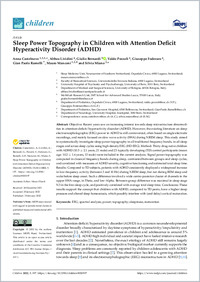Sleep power topography in children with attention deficit hyperactivity disorder (ADHD)
- Castelnovo, Anna ORCID Sleep Medicine Unit, Neurocenter of Southern Switzerland, Ospedale Civico, Lugano, Switzerland ; Faculty of Biomedical Sciences, Università della Svizzera italiana, Switzerland ; University Hospital of Psychiatry and Psychotherapy, University of Bern, Bern, Switzerland
- Lividini, Althea Department of Medical and Surgical Sciences, University of Bologna, Bologna, Italy
- Bernardi, Giulio ORCID MoMiLab Research Unit, IMT School for Advanced Studies Lucca, Lucca, Italy
- Pezzoli, Valdo Department of Pediatrics, Ospedale Civico, Lugano, Switzerland
- Foderaro, Giuseppe Department of Pediatrics, Ospedale Civico, Lugano, Switzerland
- Ramelli, Gian Paolo Department of Pediatrics, San Giovanni Hospital, Bellinzona, Switzerland
- Manconi, Mauro Sleep Medicine Unit, Neurocenter of Southern Switzerland, Ospedale Civico, Lugano, Switzerland ; Faculty of Biomedical Sciences, Università della Svizzera italiana, Switzerland ; Department of Neurology, University Hospital, Inselspital, Bern, Switzerland
- Miano, Silvia Sleep Medicine Unit, Neurocenter of Southern Switzerland, Ospedale Civico, Lugano, Switzerland
- 2022
Published in:
- Children. - 2022, vol. 9, no. 2, p. 197
English
Objective: Recent years saw an increasing interest towards sleep microstructure abnormalities in attention-deficit/hyperactivity disorder (ADHD). However, the existing literature on sleep electroencephalographic (EEG) power in ADHD is still controversial, often based on single electrode recordings, and mainly focused on slow wave activity (SWA) during NREM sleep. This study aimed to systematically investigate sleep power topography in all traditional frequency bands, in all sleep stages and across sleep cycles using high-density EEG (HD-EEG). Method: Thirty drug-naïve children with ADHD (10.5 ± 2.1 years, 21 male) and 23 typically developing (TD) control participants (mean age: 10.2 ± 1.6 years, 13 male) were included in the current analysis. Signal power topography was computed in classical frequency bands during sleep, contrasted between groups and sleep cycles, and correlated with measures of ADHD severity, cognitive functioning and estimated total sleep time. Results: Compared to TD subjects, patients with ADHD consistently displayed a widespread increase in low-frequency activity (between 3 and 10 Hz) during NREM sleep, but not during REM sleep and wake before sleep onset. Such a difference involved a wide centro-posterior cluster of channels in the upper SWA range, in Theta, and low-Alpha. Between-group difference was maximal in sleep stage N3 in the first sleep cycle, and positively correlated with average total sleep time. Conclusions: These results support the concept that children with ADHD, compared to TD peers, have a higher sleep pressure and altered sleep homeostasis, which possibly interfere with (and delay) cortical maturation.
- Collections
- Language
-
- English
- Classification
- Medicine
- License
- Open access status
- gold
- Identifiers
-
- DOI 10.3390/children9020197
- ARK ark:/12658/srd1326698
- Persistent URL
- https://n2t.net/ark:/12658/srd1326698
Statistics
Document views: 71
File downloads:
- Castelnovo_2022_MDPI_children: 113
